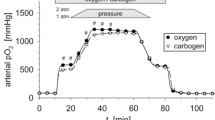Summary
Laser Doppler fluxmetry and oxygen partial pressure (pO2) histography have been applied to investigate the acute effects of hyperthermia (HT) and/or hyperglycaemia (HG) on microcirculatory function and tissue oxygenation of subcutaneous rat tumours growing on the dorsum of the hind foot. The experiments were performed to test whether, and to what extent, the two adjunct treatment modalities applied alone or in combination can modify these therapeutically relevant parameters. Local HT was performed in a saline bath (44°C) for 2 h; HG was induced by i.v. infusion of 40% glucose solution for 2.5 h (blood glucose levels: 35–40 mM, during heating). Laser Doppler flux (LDF) in superficial tumour tissue regions was recorded over the entire treatment period; tumourpO2 distribution was evaluated immediately after termination of the treatment. HG alone reduced the average LDF signal to 18% of the baseline reading before treatment, but did not influence the tumour oxygenation status and the proportion ofpO2 readings occurring in the radiobiologically hypoxic class (pO2=O–2.5 mm Hg). This phenomenon is most probably due to the occurrence of the Crabtree effect (reduction of the O2 consumption rate when excess glucose is available within a malignant tumour). Hyperthermia alone reduced LDF to approximately the same extent, and led to a rise in the number ofpO2 readings in the hypoxic range with only minor changes in the averagepO2. The combined treatment (HT/HG) neither increased the fraction of “hypoxic”pO2 readings nor intensified the flow drop already present at the end of the tumour heating. It is thus concluded that under hyperglycaemia the oxygenation status of normothermic and heated tumours is maintained. It may therefore be hypothesized that hyperthermia in conjunction with hyperglycaemia might be a better “radiosensitizer” than hyperthermia alone.
Similar content being viewed by others
Abbreviations
- NT:
-
normothermia
- HT:
-
hyperthermia
- NG:
-
normoglycaemia
- HG:
-
hyperglycaemia
- LDF:
-
laser Doppler flux
- pO2 :
-
oxygen partial pressure
References
Ardenne M von (1966) Syncarcinokolyse in Gestalt der Mehrschritt-Therapie. In: Doerr W, Lindner F, Wagner G (eds) Aktuelle Probleme aus dem Gebiet der Cancerologie. Springer, Berlin Heidelberg New York, pp 128–143
Ardenne M von, Reitnauer PG (1982) Die manipulierte selektive Hemmung der Mikrozirkulation im Krebsgewebe. J Cancer Res Clin Oncol 103:269–279
Ardenne M von, Chaplain RA, Reitnauer PG (1969) In-vivo-Versuche zur Krebs-Mehrschritt-Therapie mit der Attackenkombination „Optimierte Tumorübersäuerung + Hyperthermie + schwache Röntgenbestrahlung”. Dtsch Gesundheitwes 24:924–935
Calderwood SK, Dickson JA (1980) Effect of hyperglycaemia on blood flow, pH, and response to hyperthermia (42°C) of the Yoshida sarcoma in the rat. Cancer Res 40:4728–4733
Crabtree HG (1929) Observation on the carbohydrate metabolism of tumours. J Biochem (Cambridge) 23:536–545
Hiraoka M, Hahn M (1990) Changes in pH and blood flow induced by glucose and their effects on hyperthermia with or without BCNU in RIF-1 tumours Int J Hyperthermia 6:97–103
Jain RK, Shah SA, Finney PL (1984) Continuous noninvasive monitoring of pH and temperature in rat Walker 256 carcinoma during normoglycemia and hyperglycemia. J Natl Cancer Inst 73:429–436
Kalmus J, Okunieff P, Vaupel P (1989) Effect of the intraperitoneal versus intravenous glucose administration on laser Doppler flow in murine FSaII tumors and normal skin. Cancer Res 49:6313–6317
Koutcher JA, Fellenz MP, Vaupel PW, Gerweck LE (1988) FSaII mouse tumor metabolic changes with different doses of glucose measured by31P nuclear magnetic resonance. Cancer Res 48:5917–5921
Krag DN, Storm FK, Morton DL (1990) Induction of transient hyperglycaemia in cancer patients. Int J Hyperthermia 6:741–744
Krüger W, Mayer WK, Schaefer C, Stohrer M Vaupel P (1991) Acute changes of systemic parameters in tumour-bearing rats, and of tumour glucose, lactate, and ATP levels upon local hyperthermia and/or hyperglycaemia. J Cancer Res Clin Oncol 117:409–415
Lippmann HG, Graichen D (1977) Glukose- und K+-Bilanz während hochdosierter intravenöser Glukosezufuhr. Infusionstherapie 4:166–178
Osinsky SP, Bubnovskaja LN, Povzitkova MS (1991) Different schedules of induced hyperglycaemia cause non-uniform changes of the same homeostasis indices. Int J Hyperthermia 7:975–976
Reinhold HS, Endrich B (1986) Tumour microcirculation as a target for hyperthermia. Int J Hyperthermia 2:111–137
Roszinski S, Wiedemann G, Jiang SZ, Baretton G, Wagner T, Weiss C (1991) Effects of hyperthermia and/or hyperglycaemia in pH andpO2 in well oxygenated xenotransplanted human sarcoma. Int J Radiat Oncol Biol Phys 20:1273–1280
Vaupel P (1990) Pathophysiological mechanisms of hyperthermia in cancer therapy. In: Gautherie M (ed) Biological basis of oncologic thermotherapy. Springer, Berlin Heidelberg New York, pp 73–134
Vaupel P, Kallinowski F (1987) Physiological effects of hyperthermia. Recent Results Cancer Res 104:71–109
Vaupel P, Okunieff PG (1988) Role of hypovolemic hemoconcentration in dose-dependent flow decline observed in murine tumors after intraperitoneal administration of glucose or mannitol. Cancer Res 48:7102–7106
Vaupel P, Günther H, Grote J (1972) Einfluß einer Hyperglykaemie auf die Sauerstoff- und Glucoseaufnahme von Implantationstumoren (DS-Carcinosarkom) in vivo. Z Krebsforsch 77:17–25
Vaupel P, Otte J, Manz R (1982) Oxygenation of malignant tumors after localized microwave hyperthermia. Radiat Environment Biophys 20:289–300
Vaupel P, Okunieff P, Kluge M (1989a) Laser Doppler flowmetry in subepidermal tumours and in normal skin of rats during hyperthermia and/or hyperglycaemia. Int J Hyperthermia 5:199–210
Vaupel P, Kallinowski F, Okunieff P (1989b) Blood flow, oxygen and nutrient supply, and metabolic microenvironment of human tumors. A review. Cancer Res 49:6449–6465
Vaupel P, Okunieff P, Kallinowski F, Neuringer LJ (1989c) Correlation between31P-NMR spectroscopy and tissuepO2 tension measurements in a murine fibrosarcoma. Radiat Res 120:477–493
Ward KA, Jain RK (1988) Response of tumours to hyperglycaemia: characterization, significance and role in hyperthermia. Int J Hyperthermia 4:223–250
Ward KA, Jain RK (1991) Blood flow response to hyperglycemia. Funktionsanalyse Biol Syst 20:87–107
Author information
Authors and Affiliations
Additional information
Supported by the Volkswagen Foundation, grant I/65 084
Rights and permissions
About this article
Cite this article
Mayer, W.K., Stohrer, M., Krüger, W. et al. Laser Doppler flux and tissue oxygenation of experimental tumours upon local hyperthermia and/or hyperglycaemia. J Cancer Res Clin Oncol 118, 523–528 (1992). https://doi.org/10.1007/BF01225267
Received:
Accepted:
Issue Date:
DOI: https://doi.org/10.1007/BF01225267




